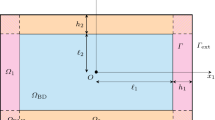Abstract
The perfectly matched layer is an efficient tool to simulate nonreflecting boundary condition at boundaries of a grid in the finite-difference modeling of seismic wave propagation. We show relations between different formulations of the perfectly matched layer with respect to their three key aspects — split/unsplit, classical/convolutional, with the general/special form of the stretching factor. First we derive two variants of the split formulations for the general form of the stretching factor. Both variants naturally lead to the convolutional formulations in case of the general form of the stretching factor. One of them, L-split, reduces to the well-known classical split formulation in case of the special form of the stretching factor. The other, R-split, remains convolutional even for the special form of the stretching factor. The R-split formulation eventually leads to the equations identical with those obtained straightforwardly in the unsplit formulation.
We also present an alternative time discretization of the unsplit formulation that is slightly algorithmically simpler than the discretization presented recently. We implement the discretization in the 3D velocity-stress staggered-grid finite-difference scheme — 4th-order in the interior grid, 2nd-order in the perfectly matched layer.
Similar content being viewed by others

References
Basu U., 2009. Explicit finite element perfectly matched layer for transient three-dimensional elastic waves. Int. J. Numer. Meth. Eng., 77, 151–176.
Basu U. and Chopra A.K., 2004. Perfectly matched layers for transient elastodynamics of unbounded domains. Int. J. Numer. Meth. Eng., 59, 1039–1074.
Bérenger J.P., 1994. A perfectly matched layer for the absorption of electromagnetic waves. J. Comput. Phys., 114, 185–200.
Bérenger J.P., 1996. Three-dimensional perfectly matched layer for the absorption of electromagnetic waves. J. Comput. Phys., 127, 363–379.
Chen Y.H., Coates R.T. and Robertsson J.O.A., 2000. Extension of PML ABC to Elastic Wave Problems in General Anisotropic and Viscoelastic Media. Schlumberger OFSR Research Note, Schlumberger, Cambridge, U.K.
Chew W.C. and Liu Q., 1996. Perfectly Matched Layers for elastodynamics: a new absorbing boundary condition. J. Comput. Acoust., 4, 341–359.
Chew W.C. and Weedon W.H., 1994. A 3-D perfectly matched medium from modified Maxwell’s equations with stretched coordinates. Microw. Opt. Technol. Lett., 7, 599–604.
Collino F. and Tsogka C., 2001. Applications of the PML absorbing layer model to the linear elastodynamic problem in anisotropic heterogeneous media. Geophysics, 66, 294–305.
Drossaert F.H. and Giannopoulos A., 2007a. Complex frequency shifted convolution PML for FDTD modelling of elastic waves. Wave Motion, 44, 593–604.
Drossaert F.H. and Giannopoulos A., 2007b. A nonsplit complex frequency-shifted PML based on recursive integration for FDTD modeling of elastic waves. Geophysics, 72, T9–T17.
Festa G., Delavaud E. and Vilotte J.-P., 2005. Interaction between surface waves and absorbing boundaries for wave propagation in geological basins: 2D numerical simulations. Geophys. Res. Lett., 32, L20306.
Festa G. and Nielsen S., 2003. PML Absorbing Boundaries. Bull. Seismol. Soc. Amer., 93, 891–903.
Festa G. and Vilotte J.P., 2005. The Newmark scheme as velocity-stress time-staggering: An efficient PML implementation for spectral-element simulations of elastodynamics. Geophys. J. Int., 161, 789–812.
Komatitsch D. and Martin R., 2007. An unsplit convolutional Perfectly Matched Layer improved at grazing incidence for the seismic wave equation. Geophysics, 72, SM155–SM167.
Komatitsch D. and Tromp J., 2003. A perfectly matched layer absorbing boundary condition for the second-order seismic wave equation. Geophys. J. Int., 154, 146–153.
Marcinkovich C. and Olsen K., 2003. On the implementation of perfectly matched layers in a three-dimensional fourth-order velocity-stress finite difference scheme. J. Geophys. Res., 108, 2276–2292.
Ma S. and Liu P., 2006. Modeling of the perfectly matched layer absorbing boundaries and intrinsic attenuation in explicit finite-element methods. Bull. Seismol. Soc. Amer., 96, 1779–1794.
Martin R. and Komatitsch D., 2006. An optimized convolution-perfectly matched layer (C-PML) absorbing technique for 3D seismic wave simulation based on a finite-difference method. Geophys. Res. Abstracts, 8, 03988.
Martin R., Komatitsch D. and Barucq H., 2005. An optimized Convolution-Perfectly Matched Layer (C-PML) absorbing technique for 3D seismic wave simulation based on a finite-difference method. Eos Trans. AGU, 86(52), Fall Meet. Suppl., Abstract NG43B-0574.
Martin R., Komatitsch D. and Ezziani A., 2008a. An unsplit convolutional perfecly matched layer improved at grazing incidence for seismic wave equation in poroelastic media. Geophysics, 73, T51–T56.
Martin R., Komatitsch D. and Gedney S.D., 2008b. A variational formulation of a stabilized unsplit convolutional perfectly matched layer for the isotropic or anisotropic seismic wave equation. Comput. Model. Eng. Sci., 37, 274–304.
Moczo P., Robertsson J.O.A. and Eisner L., 2007. The finite-difference time-domain method for modeling of seismic wave propagation. In: Wu R.-S. and Maupin V. (Eds.), Advances in Wave Propagation in Heterogeneous Earth. Advances in Geophysics, 48, Elsevier, Amsterdam, The Netherlands, 421–516.
Wang T. and Tang X., 2003. Finite-difference modeling of elastic wave propagation: A nonsplitting perfectly matched layer approach. Geophysics, 68, 1749–1755.
Author information
Authors and Affiliations
Corresponding author
Rights and permissions
About this article
Cite this article
Kristek, J., Moczo, P. & Galis, M. A brief summary of some PML formulations and discretizations for the velocity-stress equation of seismic motion. Stud Geophys Geod 53, 459–474 (2009). https://doi.org/10.1007/s11200-009-0034-6
Received:
Revised:
Accepted:
Published:
Issue Date:
DOI: https://doi.org/10.1007/s11200-009-0034-6



